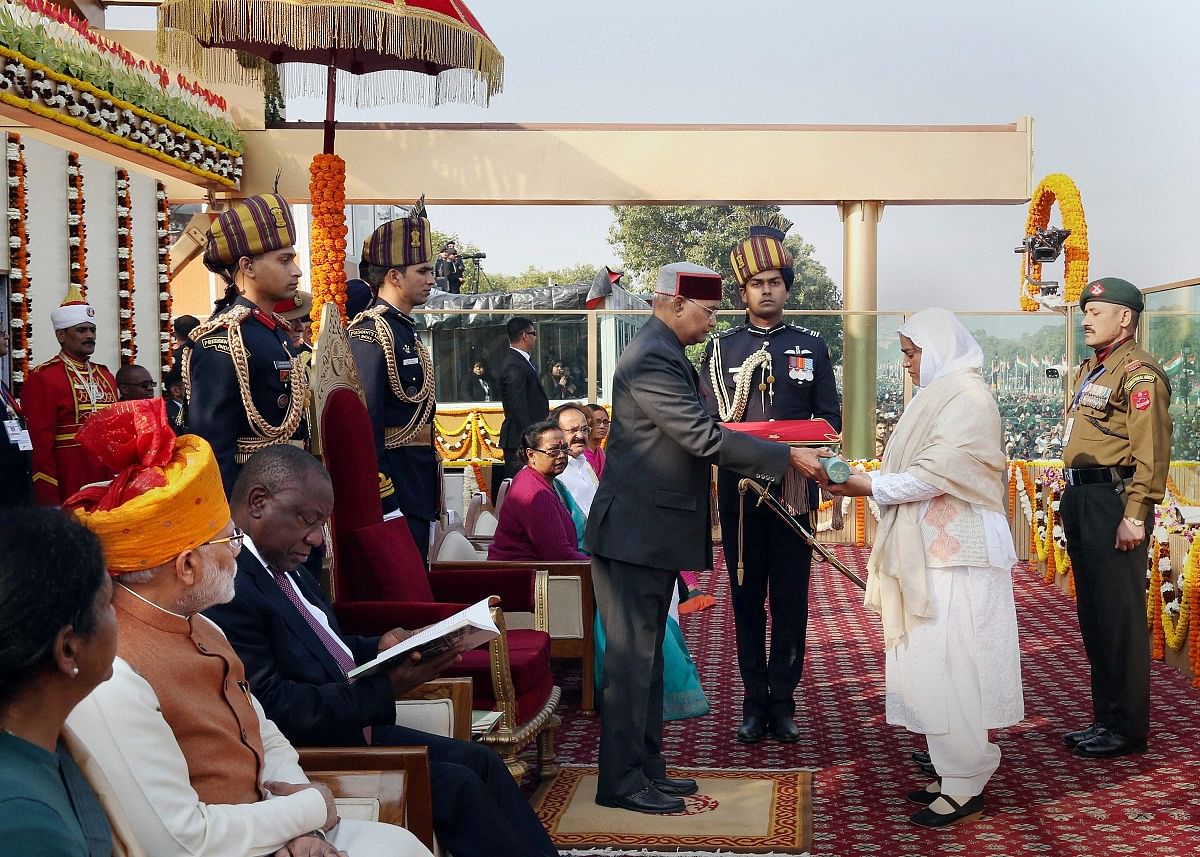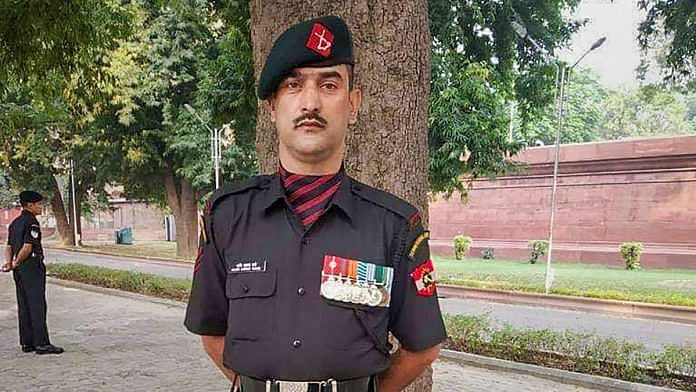Ashok Chakra recipient Lance Naik Nazir Ahmad Wani was a former Ikhwan.
This Republic Day, Lance Naik Nazir Ahmad Wani became the first Kashmiri Indian Army soldier to receive the Ashok Chakra (posthumously). What makes the award more special is that Lance Naik Wani was a former Ikhwan who was enrolled into a Territorial Army Battalion (Home & Hearth) only in 2004.
As Wani’s wife Mehjabeen received the gallantry award Saturday, many questions about his Ikhwan identity, the significance of his battalion, and his role in the Batagund Operation, in which he lost his life, remain unanswered.
Indeed, a clarity on these questions will further qualify Lance Naik Wani’s act of valour, which unfortunately some in Kashmir are condemning rather than celebrating.
Also read: Lance Naik Nazir Ahmad Wani, a former militant now an Ashoka Chakra awardee
Who are Ikhwans?
It has been widely reported that Lance Naik Wani was a former militant. That is true. To understand the context, one has to go back to the beginning of the proxy conflict in the Valley in 1989-90.
Small disparate groups had picked up arms and were frequently crossing the Line of Control (LoC) to reach Pakistan-occupied Kashmir (PoK) for training, motivation and transportation of arms and equipment. The ISI favoured the emerging militant group Hizbul Mujahideen (HM), later led by Syed Salahuddin. An alternative group of militants were brought together by Mohammad Yusuf Parray, a former folk singer from the town of Hajen near Bandipora.
The group of local Kashmiris, led by Parray, initially resisted the Indian security forces but subsequently came over ground and joined the security forces in the counter-insurgency operations.
The group was called the Ikhwan-ul-Muslimeen (Ikhwan means brotherhood) and many of its fighters had travelled to the Afghanistan-Pakistan border for arms training by the ISI during the fag end of the Soviet presence in Afghanistan.
By 1994, these fighters were deployed in three areas –Yusuf Parray (also known as Kuka Parray) in the Bandipora area, Liaqat Khan in South Kashmir and Javed Ahmad Shah operating with the J&K Police’s (JKP) Special Operations Group (SOG).

President Ram Nath Kovind presents the gallantry award Ashoka Chakra to Lance Naik Nazir Ahmad Wani’s wife Mahajabeen at the 70th Republic Day celebrations | PTI
They lived in secure camps with their families and operated in small squads attached to headquarters (HQ) and units mainly of the Rashtriya Rifles (RR). Their local knowledge of what was happening on the ground, the experience gained while fighting the Indian Army, the understanding of local language and culture enhanced the effectiveness of the Indian Army and the SOG.
Kuka Parray was the group’s most high profile leader. The close integration of the Ikhwans (as they came to be known) helped the Army and the JKP create the right conditions for the bold experiment of conducting elections in 1996. The foreign mercenaries from the Afghan war, employed by the ISI through infiltration, were largely neutralised by the joint efforts of the Army and the Ikhwan cadres through their bold forays into intelligence gathering and operations.
Nazir Ahmad Wani belonged to the Liaqat Khan group, which focused on Anantnag and Kulgam areas. The areas were allotted as per the districts from where the cadres hailed. The Liaqat Khan group’s HQ was the Janglat Mandi in Anantnag town.
Even after the elections of 1996, the Ikhwans continued supporting the Indian Army in its operations. I can recall a particularly dangerous operation on 13 January 2000 when two suicide attackers had penetrated the security of HQ 1 Sector RR at Khanabal, Anantnag and were holed up at the first floor of a set of flats. An officer had been killed and one jawan injured but a cordon was in place.
I witnessed the operation in which the local Ikhwans volunteered to enter the flat and recover the body of the officer before the house was destroyed with explosives to kill the terrorists. I found them fearless and extremely good with the use of ground and weapons.
Also read: In Kashmir, security forces plan to cut access to sites of funerals of militants
Raising Territorial Army units
As it always happens with counter-groups, the control over Ikhwans and their activities eroded over a period of time. The best way of ensuring their continued effectiveness was to instil military discipline and training, which could be done by enrolling them formally into the Army and then continuing their employment with the counter-terrorist operations.
In 2003-2004, a decision was taken to raise eight Territorial Army (TA) units of the Home & Hearth (H&H) type. H&H are units comprising sons of the soil who are permanently employed to add their weight to the operations of the Army and police. Lance Naik Nazir Ahmad Wani was enrolled in the 162 Infantry Battalion TA JAK LI (H&H) in 2004. This was one of the eight units that comprised entirely of the Ikhwan cadres. Over the years, cadres other than the Ikhwans have also joined this unit.
TA (H&H) soldiers are attached to the Rashtriya Rifles units in small numbers to provide greater insight into local conditions of the areas they operate in. Wani was attached to the 34 Rashtriya Rifles in South Kashmir after the unit returned from a challenging deployment at the LoC.
The TA (H&H) soldiers are always at the forefront with the Commanding Officer’s party, providing the backbone for such operations. Their advice and ability to guide troops through the labyrinth of lanes and streets in villages is of immense value. Wani was at the forefront of such an operation on 25 November 2018 in which he lost his life.
He was earlier decorated twice with the Sena Medal (Gallantry). His courage and expertise were a great asset to the Commanding Officer. He has now emerged as a role model for many across the country.
The Ashok Chakra for Lance Naik Wani shows that irrespective of your past, sacrifice for the nation will always be recognised by the people of India. Some in Kashmir may be unmoved by his achievements, but there are enough people to take home the right message.
The author, a former GOC of Srinagar-based 15 Corps, is associated with the Vivekanand International Foundation and the Institute of Peace and Conflict Studies. He is the Chancellor of Central University of Kashmir.





Is it really the indian awards of bravery that has now became so useless and valueless as that can be given to any one who has served in their past as a killer and muderer of innocent peopl. It looks the award has lost its value and now became the award of criminals and cowards.. I have never thought that India can disrespect and insult this Asoke Chakar Award such a way.
Sir I guess you have forgotten (or probably left intentionally) to write about the thousands of innocent civilians killed by the ikhwan. Please put some light on it. And being a former GOC, you’re aware of the fact how the ihkwanis used to operate n how many civilians fell prey to their bullets n how did these lawless gunmen enjoyed the patronage/immunity of the law/govt/army. You’re just telling the sugar-coated beginning and the climax of the story n by doing so, you’re doing injustice to your own fractured opinion. Do some introspection Sir.